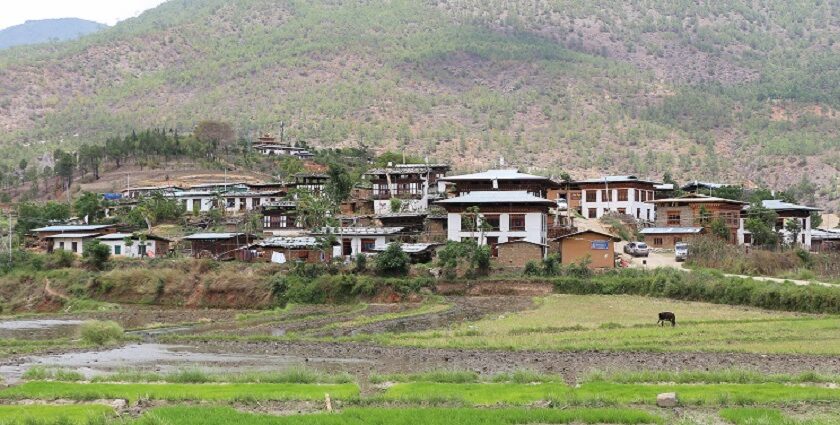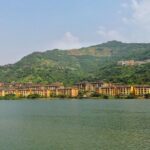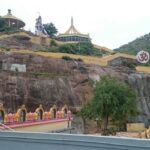Nestled in the eastern region of Bhutan, Sakteng Wildlife Sanctuary is a paradise for nature enthusiasts and wildlife aficionados. Spanning approximately 650 square kilometres, this protected area in the Trashiyangtse district is renowned for its pristine landscapes and remarkable biodiversity. The sanctuary is a vital refuge for several endangered species, including the elusive snow leopard and the charming red panda. Its diverse ecosystems, ranging from temperate forests to alpine meadows, provide a unique chance to experience Bhutan’s natural wonders in their untouched state, making it an exceptional destination for those seeking an intimate encounter with the wild.
Sakteng Wildlife Sanctuary Location
Photo: 2006nishan178713 / Wikimedia Commons
Sakteng Wildlife Sanctuary is situated in the eastern part of Bhutan, near the border with India. It spans the Trashiyangtse and Samdrupjongkhar districts and is part of the larger eastern Himalayan range.
How To Reach Sakteng Wildlife Sanctuary
Photo: Bernard Gagnon / Wikimedia Commons
Reaching Sakteng Wildlife Sanctuary involves a combination of flights, drives, and treks:
By Air: Fly into Paro, Bhutan’s international airport, then drive to Trashigang. Local transport and trekking are required to reach Sakteng from Trashigang. The journey offers scenic views of Bhutan’s landscapes.
By Trekking: The most adventurous way to reach the sanctuary is from Trashigang. This multi-day trek through rugged terrain provides a closer look at Bhutan’s natural beauty and diverse wildlife.
By Road: For those travelling by road, the journey from Phuentsholing to Trashigang is approximately 250 kilometres, followed by local transport to Sakteng.
Places To Visit Around Sakteng Wildlife Sanctuary
Discover the enchanting destinations surrounding Sakteng Wildlife Sanctuary, each offering unique experiences that complement your wildlife adventure with cultural and natural highlights.
1. Sakteng Village
Photo: Bernard Gagnon / Wikimedia Commons
Sakteng Village is a captivating traditional settlement renowned for its unique Brokpa culture. This remote village provides an authentic experience of Bhutanese life, showcasing traditional architecture with intricately carved wooden homes and vibrant, ornate decorations. Visitors have the opportunity to immerse themselves in the Brokpa way of life, observing their daily customs and practices. The villagers’ distinctive attire, characterised by colourful woven garments and traditional hats, adds to the cultural richness. Sakteng Village offers a rare glimpse into Bhutan’s cultural heritage, allowing guests to engage with local traditions and understand the enduring customs of the Brokpa people.
Timings: Open year-round
Entry Fee: Free
2. Khainey Monastery
Photo: MICHOFF / Pixabay / Image For Representation Only
Khainey Monastery, located near Sakteng, is a serene spiritual site nestled amidst breathtaking mountain scenery. This monastery holds significant religious importance for the local community, serving as a centre for spiritual practices and rituals. Visitors are drawn to its tranquil atmosphere, which provides an ideal setting for meditation and introspection. The monastery’s peaceful environment, combined with its stunning views of the surrounding mountains, enhances the spiritual experience, offering a place of solace and inspiration. Whether seeking inner peace or a deeper connection to local traditions, Khainey Monastery offers a unique and enriching retreat.
Timings: 8 AM – 6 PM
Entry Fee: Free
3. Merak Village
Photo: Ambroix / Wikimedia Commons
Merak Village is celebrated for its stunning natural beauty and traditional Bhutanese architecture. Set amidst picturesque landscapes, this village is accessible through a scenic trek from Sakteng, making it a rewarding destination for those seeking an authentic experience. The village offers a unique glimpse into the daily lives of the Merak people, who are known for their distinctive customs and vibrant cultural practices. Visitors can explore traditional houses adorned with intricate carvings and engage with the locals to gain a deeper understanding of their way of life. Merak Village provides an excellent opportunity for cultural immersion.
Timings: Open year-round
Entry Fee: Free
4. Sakteng Wildlife Sanctuary Visitor Centre
Photo: Gruendercoach / Pixabay / Image For Representation Only
The Visitor Centre at Sakteng Wildlife Sanctuary serves as a crucial hub for information about the sanctuary’s wildlife and conservation efforts. As the starting point for visitors, it provides comprehensive details on the area’s ecological importance and helps you plan your visit. The centre features informative exhibits that highlight the diverse flora and fauna of the sanctuary, along with insights into ongoing conservation initiatives. It aims to educate visitors about the environmental significance of the sanctuary and the measures being taken to protect its unique ecosystems, enhancing the overall experience and understanding of this remarkable natural reserve.
Timings: 9 AM – 5 PM
Entry Fee: Free
5. Jangphu Wildlife Sanctuary
Photo: fietzfotos / Pixabay / Image For Representation Only
Adjacent to Sakteng, Jangphu Wildlife Sanctuary is a hidden gem renowned for its lush forests and rich biodiversity. This lesser-known sanctuary provides an additional opportunity to delve deeper into Bhutan’s natural landscapes, offering diverse wildlife viewing experiences. The sanctuary’s verdant woodlands and varied habitats are home to a wide array of flora and fauna, enhancing the region’s ecological value. It is an ideal destination for those looking to extend their wildlife exploration and immerse themselves in the untouched beauty of Bhutan’s wilderness, further enriching their understanding of the country’s natural heritage.
Timings: Open year-round
Entry Fee: Free
Where To Stay
Photo: Christopher J. Fynn / Wikimedia Commons
The places around Sakteng Wildlife Sanctuary offer a variety of accommodation options to fit different budgets and preferences. For those seeking comfort, the luxurious Amankora Bumthang offers upscale amenities and stunning views of the surrounding landscapes, providing a high-end base close to the sanctuary. Budget-conscious travellers can choose from local guest houses in nearby villages like Sakteng and Merak, which offer basic amenities and a more intimate experience. These guesthouses often provide simple, home-cooked meals and insights into local culture. Booking in advance is advisable, especially during peak seasons, to secure your stay.
Where To Eat
Photo: rapidtravelchai / Wikimedia Commons
Dining options near Sakteng Wildlife Sanctuary are limited but offer a blend of local flavours and practical choices. The local eateries in Sakteng Village serve traditional Bhutanese dishes such as ema datshi (chilli cheese stew) and momos (dumplings), reflecting the region’s rich culinary traditions. For a more diverse menu, try the Merak Restaurant, which offers both local and Tibetan cuisine, including hearty dishes like thukpa (noodle soup).
Best Time To Visit
Photo: congerdesign / Pixabay /Image For Representation Only
The best time to visit Sakteng Wildlife Sanctuary is during the spring (March to May) and autumn (September to November). These seasons offer pleasant weather and clear skies, making it perfect for trekking and wildlife viewing. Winter can be harsh, with temperatures dropping significantly, while the monsoon season (June to August) may bring heavy rains, affecting travel and outdoor activities.
Other Factors To Consider
Photo: Surprising_SnapShots / Pixabay / Image For Representation Only
Cost Of The Trip:
Costs vary based on travel style. The Sakteng Wildlife Sanctuary entry fee is only 60 BTN (₹60). Budget travellers can expect to spend around 4,200-5,800 BTN (₹4,200-5,800) per day, including basic accommodation and local transport. Mid-range options may range from 8,300-12,500 BTN (₹8,300-12,500) per day, while luxury travel can exceed₹16,700 per day, including high-end lodging and guided tours.
Tips For Travellers:
- A special permit is required to enter Sakteng Wildlife Sanctuary. Ensure all necessary documentation is arranged through a licensed tour operator.
- Prepare for variable weather conditions. Bring appropriate clothing for cold and possibly wet conditions, especially if trekking.
- Carry sufficient cash, as ATMs are limited in the region.
- The Sakteng Wildlife Sanctuary’s timings are 8 am to 5 pm, so kindly plan the visit accordingly.
- While English is commonly spoken in tourist areas, learning some basic Dzongkha phrases can enhance your experience.
- Be mindful of your environment while clicking photos at Sakteng Wildlife Sanctuary.
Exploring Sakteng Wildlife Sanctuary offers a unique blend of natural beauty and cultural richness, making it a must-visit destination for wildlife enthusiasts and adventure seekers. Whether you’re captivated by its diverse wildlife or intrigued by the local Brokpa culture, Sakteng promises an unforgettable experience. To ensure a seamless and enriching journey, plan your visit with TripXL. Book now and let expert guidance take care of every detail for a memorable adventure.
Cover Photo: Bernard Gagnon / Wikimedia Commons


 WhatsApp
WhatsApp
 Twitter
Twitter



